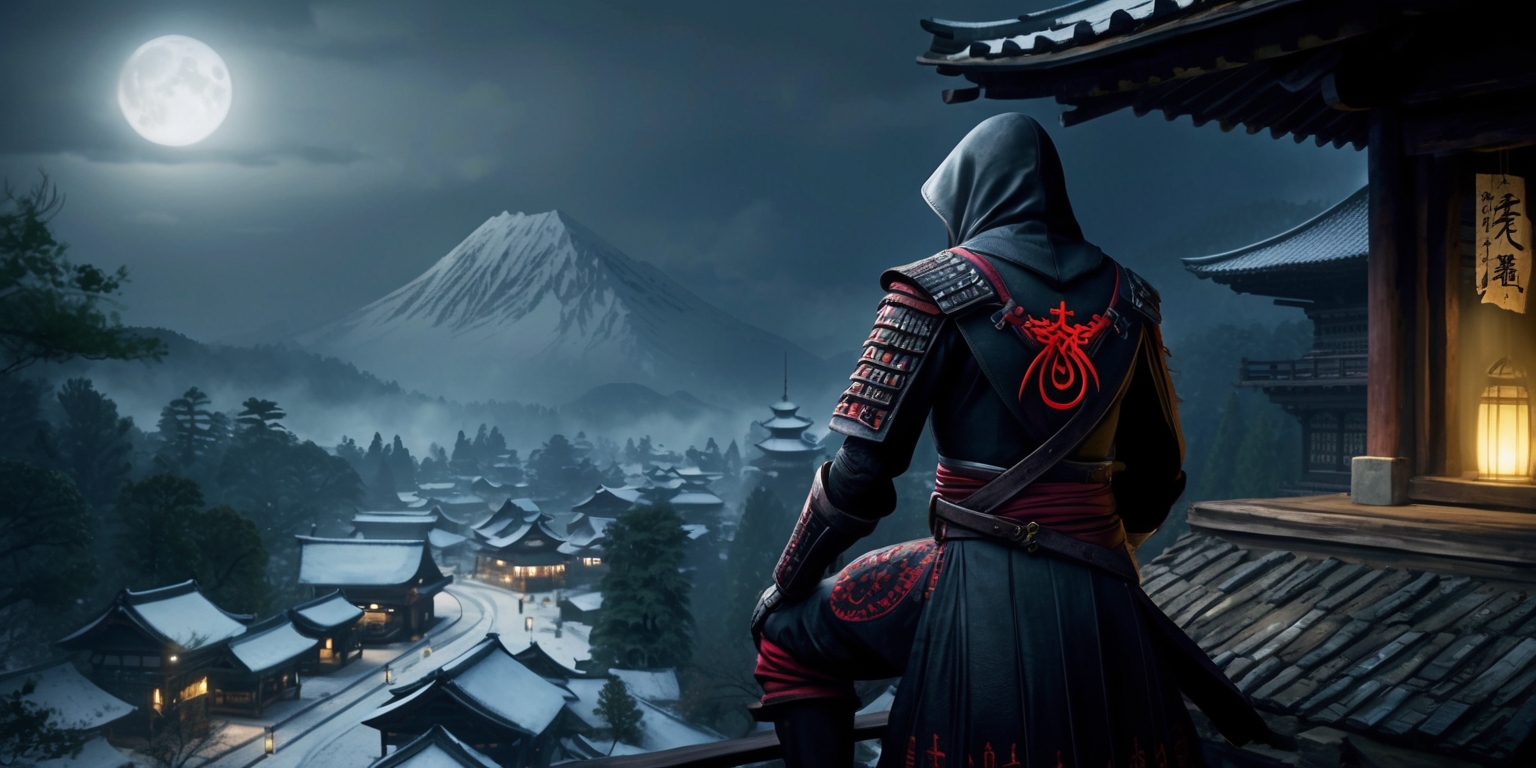Assassin's Creed Shadows: Unveiling the Hidden Conspiracies of Sengoku Japan
Jul-15-2025

The world of Assassin's Creed Shadows unfolds by transporting players to the turbulent era of Sengoku Japan where honor, strategy, and tradition collide. As ancient cultures and clandestine arts merge, players assume the roles of two distinctive figures whose intertwined fates are steeped in the legends of samurai and shinobi. This narrative adventure places the player in a rich tapestry of historical conflict, where every decision and maneuver is crucial. With A sprawling, unbounded realm waiting to be explored, where players are immersed in endless discovery introduced to systems that challenge both tactical combat and stealthy navigation. The journey is as much about the fluid mechanics of battle as it is about the subtle art of resource management and story progression, enticing enthusiasts to delve deeper into this meticulously crafted universe.
Immersive Journey in Sengoku Japan
Set during the famed warring states period of Sengoku Jidai, the game immerses its audience in a world marked by political intrigue and epic confrontations. The historical backdrop is enriched by stunning visuals that recreate the natural landscapes and urban environments of feudal Japan. Vivid details, from the elaborate architecture of ancient citadels to the rural simplicity of traditional villages, provide players with a A deep-rooted attachment to the locale that exudes genuine originality and… enchanting. The game's narrative intertwines the destinies of its protagonists with historical events, offering a layered experience that balances fictional heroics with real-world influences. This detailed environment challenges players not only to master their combat techniques but also to understand the cultural and social nuances embedded within every mission.
Dynamic Character Mechanics and Storytelling
At the heart of Assassin's Creed Shadows are its two central characters, each with a distinct style that embodies the duality of the era. One character represents the stoic samurai, a warrior whose prowess in direct confrontations is renowned across the land. In contrast, the other embodies the shadowy figure of a shinobi, adept at navigating the unseen and executing covert maneuvers. The unique mechanics allow players to seamlessly switch between these characters, each governed by its own set of skills and progression systems. This dual-character dynamic encourages players to adapt their approach based on the context of the mission. As the storyline unfolds, the intertwining fates of these figures serve as a narrative thread that deepens the emotional engagement and strategic planning required throughout the adventure.
Strategic Command at the Hideout Base
The hideout serves as a bustling hub that stands as the heart of your operations within the game. Within these fortified quarters, players can engage in resource management, construct various support buildings, and upgrade essential facilities. This base is not just for resting but actively supports your endeavors by providing utility functions that advance your mission. Each structure within the hideout plays a pivotal role; some are dedicated to forging and upgrading combat gear while others allow for resource accumulation or scout management. The careful orchestration of these facilities is essential for maintaining a competitive edge against adversaries. As players gather resources and establish effective logistical strategies, the hideout evolves, transforming into a fortified command center that mirrors your growing influence in the game.
Stealth and Combat Nuances in an Open World

Assassin's Creed Shadows offers a blend of direct combat and subtle stealth, ensuring that engagement with enemies can be approached from multiple angles. The system is finely tuned, allowing each character to utilize their inherent specialties—raw strength for the samurai and calculated irrigation for the shinobi. The combat system is layered, meaning each encounter requires a distinct tactical approach. Stealth is not just a means for silent progression but is interwoven into the narrative, enhancing the immersion of the player within the historical setting. Every skirmish, whether in crowded marketplaces or secluded battlegrounds, challenges players to consider both the immediate threat and the broader implications on their mission. The careful balance of overt confrontation and covert maneuvers underscores the game’s depth and versatility.
Quest Navigation and Objective Discovery
The pathway through Assassin's Creed Shadows is paved with intricate quests that emphasize both exploration and intelligence. Unlike earlier iterations of the series where objectives were clearly marked, this title relies on subtle cues and general directions to guide the player. Objectives are designed to encourage players to explore uncharted territories and piece together hints that lead to their targets. This approach not only tests the player's observational skills but also adds a layer of mystery to each mission. Whether tracking down elusive members of the Shinbakufu group or uncovering hidden allies in the sprawling landscape, every quest is imbued with a sense of discovery. The design encourages patience and calculated decision-making, transforming the game into a truly immersive treasure hunt brimming with historical subplots.
Refined Progression and Skill Development
Progression within the game is achieved through a meticulous system that rewards exploration and tactical acumen. Players are encouraged to accumulate Knowledge Points, which serve as the currency for unlocking higher-tier skills and enhancing abilities. The system is engineered to align with the combat and stealth dynamics of the game. Every skill point invested is a step toward tailoring the characters to a playstyle that resonates with individual players' preferences. Subtle nuances in combat techniques and defensive maneuvers can be optimized to suit the challenges each mission presents. This focus on gradual development ensures that every victory is hard-earned, making every upgrade feel meaningful. As players master the skill tree, they uncover new layers of gameplay that enrich both the strategic depth and versatility of their combat repertoire.
Resource Management and Utility Functions
The game places a significant emphasis on resource management, where the accumulation and prudent use of currency and materials can transform the tide of battle. Within the hideout, players are tasked with gathering various resources to build or enhance structures that provide vital support functions. This dynamic is Not solely centered on building wealth but also on cultivating broader values strategically utilizing these assets to enhance combat readiness and operational efficiency. Each resource serves a defined purpose, whether it is to upgrade equipment via the blacksmith or to enhance scouting capabilities. By carefully curating these resources, players create a thriving ecosystem within their base that multiplies their combat effectiveness. This blend of tactical resource allocation and narrative progression adds a unique layer of management strategy to the overall gaming experience.
Adaptable Combat Strategies and Battlefield Tactics
Engagements in Assassin's Creed Shadows require a comprehensive understanding of battlefield tactics that go beyond sheer force. Players are encouraged to adapt their strategies based on the layout of the terrain, the number of adversaries, and the inherent strengths of their chosen character. The dynamic combat system rewards cunning and foresight, allowing for a diverse range of approaches to any given confrontation. Whether engaging multiple foes or isolating a single target, every maneuver demands careful planning and precise execution. The game’s mechanics provide a fertile ground for experimenting with different combat styles, thereby keeping the action fresh and challenging. The evolving difficulty curve ensures that the player’s skill and tactical acumen are continuously tested, offering a gratifying sense of progression with every successful encounter.
Refined Utility and Base Building Functions
Beyond direct conflict, players are introduced to a robust system of base building, turning the hideout into a strategic powerhouse. The hideout is pivotal for storing and utilizing critical resources, upgrading functionalities, and maintaining a strong logistical network. Every upgrade, whether it’s expanding the scout system or enhancing equipment capabilities at the blacksmith, translates directly into improved performance during missions. The interplay between resource gathering and building enhancement forms a backbone of the gameplay experience. Players must balance immediate needs with longer-term infrastructure projects, ensuring that their hideout evolves both as a sanctuary and a strategic tool. The emphasis on utility and upkeep serves as a testament to the game’s commitment to blending narrative depth with gameplay complexity, providing a layered experience that challenges both the mind and the reflexes.
Intricate Gameplay Mechanics and Role Diversification
The game’s dual-character system offers players a unique opportunity to experience varied gameplay through two distinct roles. The samurai role features a more direct and physically imposing approach, leveraging powerful combat moves and robust defensive abilities. In contrast, the shinobi role centers around efficiency, stealth, and precision, emphasizing the importance of timing and environmental awareness. This division not only provides a refreshing contrast but also enriches the storyline by allowing players to explore different facets of historical martial arts traditions. The ability to switch roles seamlessly means that strategies can be dynamically adjusted mid-mission, fostering a gameplay environment where versatility is paramount. Each role, with its tailored skill set and respective challenges, adds another layer of depth and complexity that keeps players engaged and constantly adapting their approach.
Expansive Exploration and Hidden Narratives
One of the most alluring aspects of Assassin's Creed Shadows is the expansive open world that beckons exploration. Every corner of the game is laden with detailed environmental storytelling, where hidden narratives and side quests reveal the rich tapestry of Sengoku Japan. From secretive alleyways in bustling towns to serene landscapes shrouded in mist, players are encouraged to venture beyond well-established routes and discover the subtle histories embedded in the terrain. The game’s design philosophy prioritizes immersion, allowing players to piece together fragmented stories of long-forgotten heroes, rivalries, and cultural traditions. This careful balance of main missions and side ventures transforms the act of exploration into an art form, where every step taken unveils a new piece of the overarching narrative without diminishing the core thrust of the immersive gameplay experience.
Expanding Horizons Through Campaign Objectives
The campaign mode in Assassin's Creed Shadows introduces players to a network of objectives that require both strategic planning and fluid adaptability. Unlike more linear approaches, the objectives here are presented with broad cues that encourage active investigation. Players must diligently track members of the enigmatic Shinbakufu group, decipher historical hints, and follow cryptic leads that stretch across the sprawling map. This method keeps the campaign mode engaging and fresh, demanding constant attention to detail and rapid situational analysis. The multi-layered structure of the missions also allows for a rich interplay between main story threads and ancillary challenges, ensuring that every encounter contributes to the broader mission of unmasking hidden conspiracies. The process of objective discovery is both a test of one’s tactical planning abilities and a call to further immerse oneself in the expansive tapestry of mythology behind the game world.








